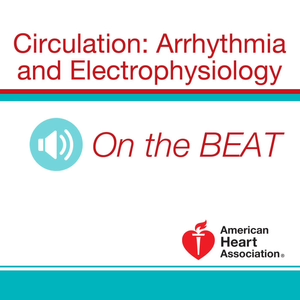
Circulation: Arrhythmia and Electrophysiology August 2019 Issue
Circulation: Arrhythmia and Electrophysiology On the Beat08/27/19 • 13 min
Dr Paul Wang: Welcome to the monthly podcast, On the Beat, for Circulation: Arrhythmia and Electrophysiology. I'm Dr Paul Wang, Editor-in-Chief, with some of the key highlights from this month's issue.
In our first paper, Mark McCauley, Flavia Vitale and associates report that carbon nanotube fibers may improve impaired myocardial conduction. In three sheep, radiofrequency ablation was used to create epicardial conduction delay. In addition, in a rodent model, carbon nanotube fibers were sewn across the atrial ventricular junction. They demonstrated acute ventricular preexcitation, but in chronic studies at four weeks, atrial pacing was required for resumption of AV conduction. Carbon nanotube fibers are conductive, biocompatible with no gross or histopathological evidence of toxicity.
In our next paper, Koichiro Ejima and associates compared outcomes of circumferential pulmonary vein isolation for atrial fibrillation ablation randomized to contact force monitoring or unipolar signal modification in 136 patients with paroxysmal atrial fibrillation. In the unipolar signal modification-guided group, each radiofrequency application was delivered until the development of completely positive unipolar electrograms. In the contact force monitoring-guided group, a contact force of 20 grams, ranged 10 to 30 grams, and a minimum force time integral of 400 gram seconds were the targets for each radiofrequency application. The freedom from atrial tachyarrhythmia recurrence at 12 months was 85% in the unipolar signal modification-guided group and 70% in the contact force monitoring-guided group, P equals 0.031. The radiofrequency time for pulmonary vein isolation was shorter in the unipolar signal modification-guided group than contact force monitoring-guided group, but was not statistically significant, P equals 0.077. The incidence of time-dependent in ATP-provoked early electrical reconnections between the left atrium and pulmonary veins, procedural time, fluoroscopic time, and average force-time integral did not significantly differ between the two groups.
In our next paper, Vishal Luther and associates tested whether ripple mapping is superior to conventional annotation-based local activation time mapping for atrial tachycardia diagnosis. Patients with atrial tachycardia were randomized, either ripple mapping or local activation time mapping. The primary endpoint was atrial tachycardia termination with delivery of the planned ablation lesion set. The inability to terminate atrial tachycardia with the first lesion set, the use of more than one entrainment maneuver, or the need to cross over to the other mapping arm were defined as failure to achieve the primary endpoint. The primary endpoint occurred in 38 of 42 patients or 90% in the ripple mapping group, and 29 of 41 patients, 71%, in the local activation time mapping group, P equals 0.45. The primary endpoint was achieved without any entrainment in 31 out of 42 patients or 74% with ripple mapping, and 18 out of 41 patients or 44% with local activation time mapping, P equals 0.01. Of those patients who failed to achieve the primary endpoint, atrial tachycardia termination was achieved in 9 out of 12 patients or 75% in the local activation time mapping group following crossover to ripple mapping with entrainment, but zero out of four patients, 0%, in ripple mapping group crossing over to local activation time mapping with entrainment, P equals 0.04.
In our next paper, Franziska Fochler and associates examined whether anatomical targeting of late gadolinium enhancement MRI-detected gaps and superficial atrial scar is feasible and effective to treat recurrent atrial arrhythmias post-atrial fibrillation ablation. The authors studied 102 patients who underwent initial atrial fibrillation ablation and repeat ablation for recurrent atrial arrhythmias within one-year. 46 patients or 45% with atrial fibrillation recurrence were assigned to group one and underwent fibrosis homogenization as the second procedure. 56 patients or 55% with atrial tachycardia recurrence were assigned to group two and underwent late gadolinium enhancement MRI detected scar-based dechanneling. Both groups underwent re-isolation of pulmonary veins, if necessary.
In the first 25 patients from group two, the atrial tachycardia was electroanatomically mapped and a critical isthmus was defined. It was found that those isthmi were located in the regions with non-transmural scarring detected by late gadolinium enhancement MRI. In the last 31 patients from group 2, an empirical late gadolinium enhancement MRI-based dechanneling was performed solely based on late gadolinium enhancement MRI results. During one-year follow-up after the second ablation, 67% of patients group one and 64% of patients group two were free from occurrence. In group two, 64% in the electroanatomic-guided and 65% in the late gadolinium enhancement MRI dechanneling group were free from ...
08/27/19 • 13 min
Episode Comments
0.0
out of 5
No ratings yet
eg., What part of this podcast did you like? Ask a question to the host or other listeners...
Post
Generate a badge
Get a badge for your website that links back to this episode
<a href="https://goodpods.com/podcasts/circulation-arrhythmia-and-electrophysiology-on-the-beat-94401/circulation-arrhythmia-and-electrophysiology-august-2019-issue-5066053"> <img src="https://storage.googleapis.com/goodpods-images-bucket/badges/generic-badge-1.svg" alt="listen to circulation: arrhythmia and electrophysiology august 2019 issue on goodpods" style="width: 225px" /> </a>
Copy